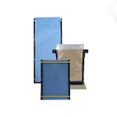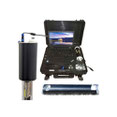Root, Rhizosphere and Soil Observation Systems
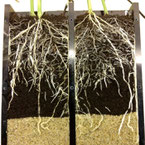
The first investigator known to have developed a root box was probably Julius von Sachs in the 19th century (Sachs, 1865). Since then, many soil-based, ex situ growth systems, today referred to as rhizoboxes, rootboxes or rooting box have been developed for research, breeding and education. Investigate the "hidden half" of plants, monitor the rhizosphere and soil under standardized conditions with VSI Rhizobox Systems. We offer an "ecosystem" of Rhizobox and Rhizotron research tools optimized for monitoring of roots and/or soil processes - durable and easy to use. Choose from a wide range of accessories (racks, manipulation stands, respiration chambers, etc.) - standard and custom sizes and many different designs available. Contact us if you want to discuss rhizoboxes, rhizotrons, hydroponic rootboxes and fitting monitoring systems.
Rhizoboxes & Rhizonboxes
Rhizoboxes for Root & Rhizosphere monitoring and root phenotyping ex situ. Request a quote for custom rhizobox designs by filling out the Rhizobox configuration form (pdf). Try our Rhizobox Configurator to plan your designs. Standard Rhizoboxes and Standard Splitboxes (with center division) (A5 to A3) are available in the online store.
Rhizonboxes for soil water sampling with (Micro-)Rhizons (perforated back panel), and soil water manipulation with RhizonIrrigators. Request quotes for custom rhizonboxes by submitting the Configuration form (pdf). Standard Rhizonboxes (A5 to A3) are available in the online store.
Hydroponic Rootboxes, for experimentation on submerged root systems, flooded soil. Standard and custom dimensions, leakproof.
Rhizobox Accessories

Rhizobox Racks (standard, compact, heavy duty) for angled - and cooling racks for angled & tempered - placement of rhizoboxes. Angled placement facilitates root visibility along the transparent front panel. Racks are custom build to match any Rhizobox dimension. Compact Racks / Racks with Gaps for standard Root Boxes are available in the online shop.
Light Shielding Panels. Covers the transparent panel(s) of Rhizoboxes to reduce light reaching the rooting zone. Easy to install, compatible with racks. Standard-size Rhizobox shading panels are available online.
Rhizobox Manipulation & Imaging Stands. Facilitate opening of a Rhizobox panel (for sampling, manipulation) or imaging (A4/letter size and less wide boxes only) while plants are still growing inside - reducing the risk of damaging protruding plants. Standard Stands in the shop.
Gas Flux & Isotope Labelling Chambers. Use matched respiration chambers on top of rhizoboxes or mobile rhizotrons to combine root monitoring with gas flux measurements and isotope labelling.
Rhizon Soil Water Samplers. Versatile, small-volume soil pore water samplers for Rhizo- and Rhizonboxes. Various types available.
RhizonIrrigators. Passive irrigation & fertilisation of Rhizoboxes, Rhizonboxes, and Rhizotrons at different depths - creating realistic soil moisture pattern. Implement depth-stratified soil pollution treatments.
Mobile Rhizotrons and Root Windows
Mobile Rhizotrons. Large-scale "rhizoboxes", mobile, for educative displays, and root, rhizosphere, soil experimentation in greenhouses - woody plants and plant communities to 2 m depth.
Root Observation Windows, for root and rhizosphere monitoring under field conditions or integrated into walk-in rhizotron facilities - fully customized set-up.
Rhizobox Imaging, Gas Fluxes and Root Extraction
Rhizobox Imaging Systems. Efficient and high quality automatic or semi-automatic imaging of rhizoboxes. The modular systems can be adapted to a wide range of rhizobox and plants dimensions. Read more about the automatic Rhizobox Phenotyping Platform (incl. shoot) and/or the semi-automatic LK-1250 Rhizobox Imager.
Root and Soil Gas Flux Systems, for root and soil gas exchange measurements to combine with rhizobox studies - Soil Respiration System, Root O2 consumption, Soil Methane Analyser-
Root Washing System. For efficient, semi-automated root elutriation from rhizobox soil compartments at harvest, consider the Semi-Automatic Root Elutriation System - processing 4 or 8 soil samples in parallel.
Get Inspired: Special Rhizobox/Rootbox Designs
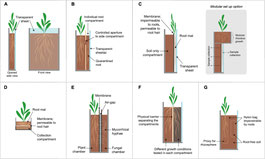
- Rhizobox / root box systems are used to i) separate rhizosphere soil from bulk soil, ii) are a feasible way to study different aspects of soil - soil pore water - root interactions, iii) measure root growth, turnover and spatial distribution (and a wide range of other root traits relevant to characterize root systems in phenotyping approaches), and image the rhizosphere, and iv) sample defined root types (e.g. age classes, orders) or soil areas (rhizosphere/bulk soil). Rhizonboxes are particularly useful to sample / manipulating specific rhizosphere patches. Show more
-
Recently, Yee and colleagues (2021) provided an excellent overview of representative rhizobox designs, demonstrating the variety of rhizobox configuration options for specific research questions (see Figure). (Subpanel A) "Classic" Rhizotron/Rhizobox design, (B) Rhizobox with side compartment, (C) vertical and (D) horizontal root mat chambers, root boxes with (E) mycorrhizal compartments (e.g. separated by 50 µm mesh and/or air gaps), and (F,G) split root or box designs (see "Splitbox design") with full or semi-permeable compartments. See Yee et al. (2021) for details.
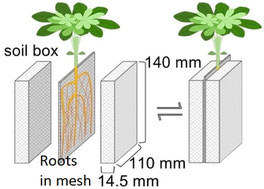
Similarly innovative, Yin et al. (2020) proposed a "sandwich" rhizobox system - growing roots in nylon mesh between two rhizobox halves with soil, allowing for easy retrieval of 2D root systems for subsequent analysis, analogous to soil-free growing paper-based phenotyping systems, but with the advantage of harvesting roots exposed to soil incl. its rhizosphere microbiome and unique abiotic conditions. See below for some general design consideration when planing your Rhizobox design. In particular, please consider the target plant size when selecting a certain rhizobox size, and the potential effect of root illumination. The integration of RRPs' (Micro-)Rhizons and RhizonIrrigators into the Rhizobox systems (or "Rhizonboxes") creates advanced opportunities for soil water sampling and manipulation in root boxes. Rhizobox racks for angled placement and top-up rhizobox gas flux chambers measurements or isotope labelling complement our root box portfolio. For studies under flooded soil conditions, we are offering hydroponic rootboxes.
| References | Rhizobox Designs | OPEN |
|
||
Design Considerations for Root & Rhizosphere Research in Custom Root Boxes
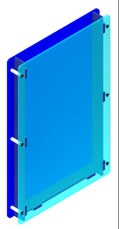
- We are happy to discuss your research ideas involving root boxes as versatile root and soil monitoring systems. Contact us to get rhizobox (or rhizotron) design recommendations fitting your experimental goals, species etc. You can order standard rhizoboxes, rhizonboxes and splitboxes (paper size A3 - A5 outside dimensions, 3 cm deep) and accessories via the rhizobox webstore (within the EU). For your custom root box design, you may want to consider... Show more
-
- Internal/external dimensions (W x H x D) depending on the species (size, growth rate) and duration of the experiment. See also the rhizobox calculator tool to determine suitable rootbox dimensions (i.e. rootable space).
- Detachability of front and backplates. Lowered hex screws for easier scanning and back-to-back placement, or wing nuts for easy opening during routine sampling? Independently detachable sections for easier sampling?
- Splitbox design to independently monitor two (or more) plant individuals per rhizobox? Or do you need to grow the root system of one plant in two different compartments (SplitRoot-Box design).
- Backplate perforation for soil pore water sampling with Microrhizons, and/or holes for insertion of Rhizon samplers from the side?
- Bottom perforation, allowing for drainage? Did you consider a drainage layer at the bottom? Or do you need sealed hydroponic RootBoxes for flooding experiments?
- Rack system to place rhizoboxes? Angled to facilitate root growth along the transparent front? Are your boxes very tall and very heavy - consider a support (heavy-duty) rack.
- How do you prevent light reaching the root system? Light cover panels? Box systems? Foil or film?
- How do you image your rhizoboxes? Semi-automatic or automatic rhizobox imaging systems needed for your root research facility?
The rhizobox configuration form and some exemplary rhizobox pictures provide a good overview of possible rhizobox designs, but we are always open to realize your special requirements. For example, ultra large rhizoboxes for educational displays ("rhizotrons") or hydroponic rootboxes require different construction principles due to the weight of soils and large plants, waterproof sealing etc.
Rhizoboxes and Rhizobox accessories in transparent and black are available in 3-5 mm PMMA with a recycling rate of 70%. Contact us if a more sustainably produced acrylic fits your research needs. Contact us via WhatsApp or email to discuss your custom rhizobox design ideas!
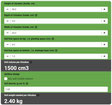
Try our rhizobox configurator web tool to set the target dimensions of rhizoboxes / rhizonboxes, calculate the effects on rooting and rhizosphere space, overall weight of rootboxes and approximate the amount of soil required.

Rhizoboxes and Rhizobox accessories in transparent and black are available in 3-5 mm PMMA with a recycling rate of 70%. Contact us if a more sustainably produced acrylic fits your research needs.
Standard Rhizoboxes & Accessories - Online Shop
Ultra large rhizoboxes (Mobile Rhizotrons) are an excellent choice to exemplify the importance of root systems for plant growth and yield to stakeholders & the public in permanent displays and to conduct large-scale greenhouse experiments. Read more about Rhizotron Facilities / Undeground Root Laboratories - the origins of modern Rhizobox designs.
Software to Analyse Root Traits - Examples
Roots on rhizobox / root box transparent surfaces or after harvest can be analysed with a growing range of free or commercial software programs. However, rhizoboxes are also an educative way to illustrate root (and shoot growth) to younger audiences. Here we give a brief onverview on potential programs to use for image analysis:
- DIRT (for registered iPlant collaborators)
- IJ_Rhizo, ImageJ macro
- RhizoVision Explorer (Open Source)
- RootNav (Open Source)
- SmartRoot (freeware)
- RhizoChamberMonitor (freeware)
- WinRhizo, Regent Systems, Canada (commercial)
- WinRhizo Tron, Regent Systems, Canada (commercial)
Please check the Plant Image Analysis Webpage (carefully collected by Guillaume Lobet and colleagues) for further software packages allowing root analysis.
[Vienna Scientific Instruments is not responsible for the content of external links. ]
UHD Minirhizotron Root Imaging Systems for non-destructive monitoring of roots in situ with transparent MR tubes.
RhizoPot Scanner System LK-1600 for continuous imaging of roots in permanently attached rhizoboxes ("RhizoPots") - modified version for automatic root window imaging available.






















